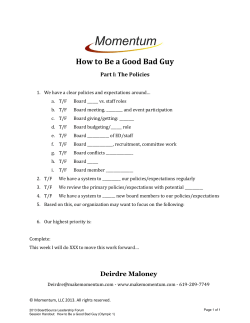
Ask Tom Questions, Continued...
Ask Tom Questions, Continued... The following is not an advertisement. It is a public interest article. By Tom Lincir President, Ivanko Barbell Company Due to over-flow of questions posed to Tom, we’ve decided to continue the Ask Tom Ivanko installment in this issue. Hi Tom, Just discovered your site [www.ivankobarbell.com] and found it very interesting with a lot of good information. I bought 2 used olympic weight sets and found one with bearing ([brand redacted] - used but looks in very good condition) and one with a bushing ([brand redacted] - almost brand new... used for 2 days before I bought it). Both of them have sloppyness when unloaded and I grab the very end of the bar and lift up and down. At first I thought the hex bolt was loose but have ruled that out. It looks to me like it might just be the way they are designed. We are only talking about 1-2 mm of play up and down but I was expecting none. Is this normal? 2nd question - is it common practice for the end sleeves to be removed and the bearings/bushings greased? If so, is it OK to use an impact gun to remove the hex bolts since I am not strong enough to keep the bar from spinning when I put my hex socket/ratchet on it. Thanks a bunch Steve (via e-mail). Dear Steve, Both of the bars you have are made in China. They are notorious for sloppy tolerances. There is no easy way to reduce the slop. You might as well start over. The best way to remove the bolt is with an impact hammer. They were, most likely, installed with a thread adhesive. To lube a bar, you only need one or two drops of 20 weight regular oil, once a month. cutting off the knurling. However most of the decent bars I have looked at e.g. eleiko competition bar, riptoe burgner mens bar etc including yours have these hand spacing rings on the knurling so, I’m a bit confused. I was wondering if you could clear this up for me. Thank you hope to hear from you soon. :) Kind regards Mubarak (via e-mail). Hi Mubarak, It is very simple. There’s a right way and a wrong way to make an Olympic bar. The wrong way is how you get a “suicide groove,” a term I originally coined in a previous article, “How to Break an Olympic Bar,” NTFJ (Fall, 2002). As I’ve written previously, these grooves are cut into the bar for cosmetic reasons. But they can have dangerous consequences. And they are perhaps the most stupid and dangerous practice among Olympic bar manufacturers because the method involves completely knurling a bar, then coming back afterwards and making hand spacing marks (or “rings”) by cutting off the knurling and cutting grooves into the bar! Some probably think it looks nice, but the grooves reduce the diameter of the bar at that point and consequently, the strength of the bar. Over the years, I’ve seen dozens of bars snap off at these week points. The only safe way to knurl a bar is to stop the machine and lift away the knurling tool, and move it over to create the spacing rings. The second method (“the wrong way”) is the way you weaken the steel. Often a Suicide Groove Your best bet would be to look for a used Ivanko bar. We have them once in awhile on our website. Then sell your two Chinese bars. Regards, Tom Hi there, I read that article “How to break an Olympic bar” and the part about suicide grooves, where hand spacing rings are made by 22 A well-known bar snaps NATIONAL FITNESS TRADE JOURNAL precursor to bar failure, this second method can (and has) lead to a bar snapping and to well-documented injuries. I also wrote about a few bars that had snapped at this groove, back in the Spring 2009 issue of NTFJ in a piece entitled “Raising the Bar and More Bar Failure”. Both this article & the previous one are available as back issues or can be downloaded for our website. Additionally, some photos of suicide grooves and broken bars can be found on our Facebook site. But here are two of them for your edification: Tank Meeting” and arrived at the “decision” that the Ivanko bar was “good enough.” But I was a little worried about what the one guy had said because he was one of the first guys to squat 1000 even though he was wrapped up better than King Tut and had so many chemicals in him he’d have had to have gotten a hazardous waste permit to take a piss. Anyway, at that meet as I remember it, everything went along fine. The result was that Eddie Coan broke about four records - bench press, squat, deadlift, and total -- and after the meet I asked Eddie: “Was there something wrong with the bar?” And he replied: “Gee Tom, I didn’t notice. Was there?” The point? Bar from local gym which snapped at groove, c. 2010 Fight on, Tom Lincir Dear Tom, I read your last article where you said that often the bar that a guy starts out with is the bar that he thinks is best for a squat, deadlift or whatever. If this is the case, what role, if any, does equipment play in a competition? Ralph. Dear Ralph, While I think the quality of the equipment does play a role in performance (you’ll remember that in the previous issue I outlined my argument -- and the argument of others -- for the superiority of bushing over bearing bars as one example of this type of idea). I think this anecdote might illustrate a useful point to remember: I don’t remember the year off-hand, but at a USPF National Championship in the late 80’s, they asked me to supply the plates and the bar. The meet was going perfect. When they got up to the super heavy-weights, one well-known guy, who was then on the “juice,” remarked that he didn’t like my bar. Rather, he wanted a special bar that was out of regulation. I said if my bar is no good, then neither are my plates. And if this is the case, I’m packing everything up and taking off. The top guys in the association had a 15 minute “Executive Think “Great lifters set records. Guys who miss lifts are always blaming the equipment.” Tom Future Articles & A Call for Contributions: I’m working on three articles that I’ve been collecting information for, for a long time. Stupidest Injuries at the Gym Every manufacturer is occasionally plagued with nuisance lawsuits derived from alleged injuries in the gym. I’ve documented and warned of some of the injuries that have resulted from faulty free-weight & machine designs and equipment in the past. These problems deserve recognition as well as condemnation, because often, I think, many could have been prevented. But there’s another type of injury that occurs in the gym that falls into the scheme of that internet sensation, the “Darwin Awards,” and I’ve been collecting documentation of such injuries since the 60’s. Among my favorite, so far, is the one about the guy who sued machine manufacturers because he got his “business end” chopped off in a weight stack. Why it was there, no one seems to know, least of all the guy who it happened to. I learned about this one because Ivanko used to make the weight stack systems for many of the major domestic manufacturer’s of gym equipment and when someone gets hurt at a gym, the lawyers usually sue the machine manufacturer, the manufacturer of OEM accessories & equipment (if any), the free weights that happen to be near the machine at the time of alleged injury, gym trainers or employees, the gym itself, the city, the gym personnel and anyone else conveniently around at the SUMMER 2011 | 23 time. With regard to the injury above, my question has always been what was this guy doing having unlawful carnal knowledge with a cast-iron weight stack? Biggest Flops in the Barbell Business You’d be surprised (or not) by how many apparently ingenious (yet pointless) machines, free weight apparatus, and accessories have been “invented”. If you’ve got a favorite, let me know. I’m working on my own top 10 list. Companies that Endure • PT Check-in & Session Tracking • Tanning Sun Station • Member & Financial Reporting • Prospecting & Sales Management • Kid Care Administration • 35+ Years in the Fitness Industry Paramount (1954). ProMaxima (1965). Ivanko Barbell Co. (1967). Tuff Stuff (1971). Strength Inc (1974). Hoggan Health (1977). Keiser (1978). Magnum (1978). Hoist Fitness (1979). What do all these companies have in common? Each was founded before 1980 and each continues to operate under the aegis of its founder or founding family. These days, that’s pretty rare. Companies in our industry are bought and sold, change direction either substantially (their product line) or superficially (their “marketing” approach); but few endure let alone prevail. In a forthcoming issue, I’ll take the opportunity to consider these companies in more detail and what factors have led to their continuity and success. Please join on us at facebook.com/ ivankobarbell where we publish original content, product announcements, and specials for your facility. Ivanko Barbell Company was founded by Tom Lincir in 1967 and is the most respected manufacturer of professional and commercial grade barbell and dumbbell products worldwide. Your comments or questions are welcome. Contact Tom at tom@ivankobarbell.com or write to: Complete Software and Billing Solutions CALL: 1-800-316-4444 www.ParamountAcceptance.com 24 P.O. Box 1470, San Pedro, CA 90733 U.S.A. For product information, pricing, and our newsletter sign-up, see our website ivankobarbell.com or call (310) 514-1155. NATIONAL FITNESS TRADE JOURNAL
© Copyright 2025





















